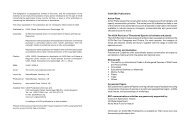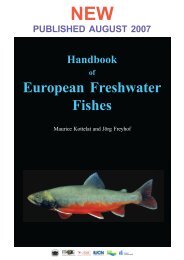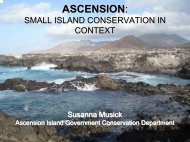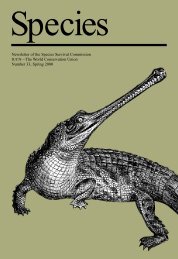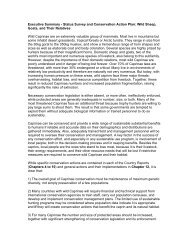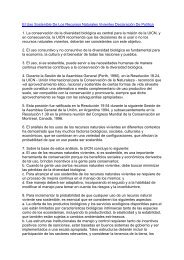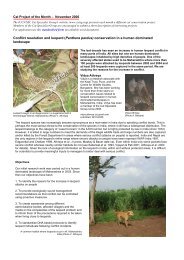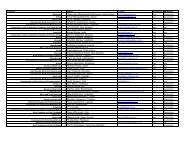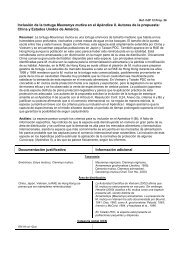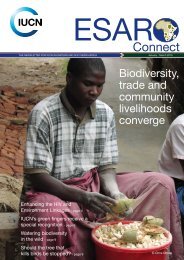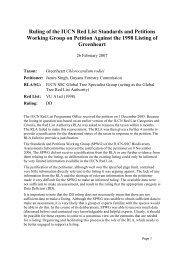Planning education to care for the earth - IUCN Knowledge Network
Planning education to care for the earth - IUCN Knowledge Network
Planning education to care for the earth - IUCN Knowledge Network
You also want an ePaper? Increase the reach of your titles
YUMPU automatically turns print PDFs into web optimized ePapers that Google loves.
<strong>Planning</strong> <strong>education</strong> <strong>to</strong> <strong>care</strong> <strong>for</strong> <strong>the</strong> <strong>earth</strong>with local families. Finally, <strong>the</strong> project was directed by <strong>the</strong> same person <strong>for</strong>12 years and <strong>the</strong>n handed over <strong>to</strong> ano<strong>the</strong>r conservation professional, aFrench-speaking citizen of Quebec.EvaluationThe management plan achieved its three aims.Populations of breeding seabirdsMost seabird populations breeding in sanctuaries along <strong>the</strong> Quebec NorthShore increased - some dramatically - between 1977 and 1988. Theincreases - <strong>the</strong> figures given are approximate - were greatest among <strong>the</strong>Alcids: Common Murre (10,200 <strong>to</strong> 26,000), Razorbill (3,600 <strong>to</strong> 7,000),Atlantic Puffin (15,200 <strong>to</strong> 35,000). The numbers of Common Eider andCommon/Arctic Terns (Sterna hirundo and S. paradisaea) also rose. Theexplanations of <strong>the</strong>se increases include better en<strong>for</strong>cement and <strong>the</strong> likelihoodthat more prey food was available. The <strong>education</strong> programme, however,contributed <strong>to</strong> a marked reduction in hunting and egg harvesting at <strong>the</strong>colonies; increased productivity and recruitment rates of <strong>the</strong> bird populationwould not o<strong>the</strong>rwise have been possible.The lesson is that local support <strong>for</strong> <strong>the</strong> management ef<strong>for</strong>t and <strong>the</strong>combination of <strong>education</strong> and en<strong>for</strong>cement <strong>to</strong> reduce illegal harvesting wereessential elements in <strong>the</strong> recovery of <strong>the</strong> bird populations.Improvements in knowledge, attitudes and behaviourA comparison of similar surveys made in 1981 and 1988 showed that localknowledge of wildlife regulations and attitudes <strong>to</strong>wards hunting and levels ofharvesting of seabirds had significantly improved. The legal status of <strong>the</strong>Common Murre was stated correctly by 47 percent of respondents in 1981,64 percent in 1988. The proportion who thought it was all right in general <strong>to</strong>take seabirds and eggs declined from 95 <strong>to</strong> 90 percent, while those whothought it should be legal <strong>to</strong> hunt Atlantic Puffin were halved (54 <strong>to</strong> 27percent). Despite <strong>the</strong> continued belief that birds should be harvested <strong>for</strong>food, an individual’s perspective on <strong>the</strong> level of harvest changeddramatically. The 1988 survey showed that 48 percent of families werebelieved <strong>to</strong> harvest eggs and seabirds compared with 77 percent 7 yearsearlier. The number of birds identified as needed by a single family each yearhad fallen from 44 <strong>to</strong> 24.Greater local involvement in wildlife managementGreater local involvement in wildlife management can be measured invarious ways. These include increased membership in <strong>the</strong> local wildlifesociety and youth conservation clubs; more applicants <strong>for</strong> conservation jobs;increased demand <strong>for</strong> places in <strong>the</strong> St Mary’s Island Youth Programme; <strong>the</strong>emergence of conservation committees; local activism (<strong>for</strong> example, harbourclean-ups); and requests <strong>for</strong> conservation and <strong>to</strong>urism training programmes.Training, with <strong>the</strong> emphasis on greater local involvement, has become <strong>the</strong>principal direction of <strong>the</strong> programme. ( Blanchard and Nettleship, 1992, andBlanchard, 1994)44



